您好,登录后才能下订单哦!
本篇内容主要讲解“Android以对话框形式制作数字软键盘怎么实现”,感兴趣的朋友不妨来看看。本文介绍的方法操作简单快捷,实用性强。下面就让小编来带大家学习“Android以对话框形式制作数字软键盘怎么实现”吧!
Android的大部分自定义软键盘主要是通过android自带控件KeyboardView实现的。
那么,有没有其他简单易上手的方法来制作一个软键盘呢?
当当当当!!!
这里就要说到对话框形式的软键盘啦,简单方便易理解!
下面,通过自定义的数字软键盘来介绍如何利用对话框实现自定义软键盘!
先看看效果!
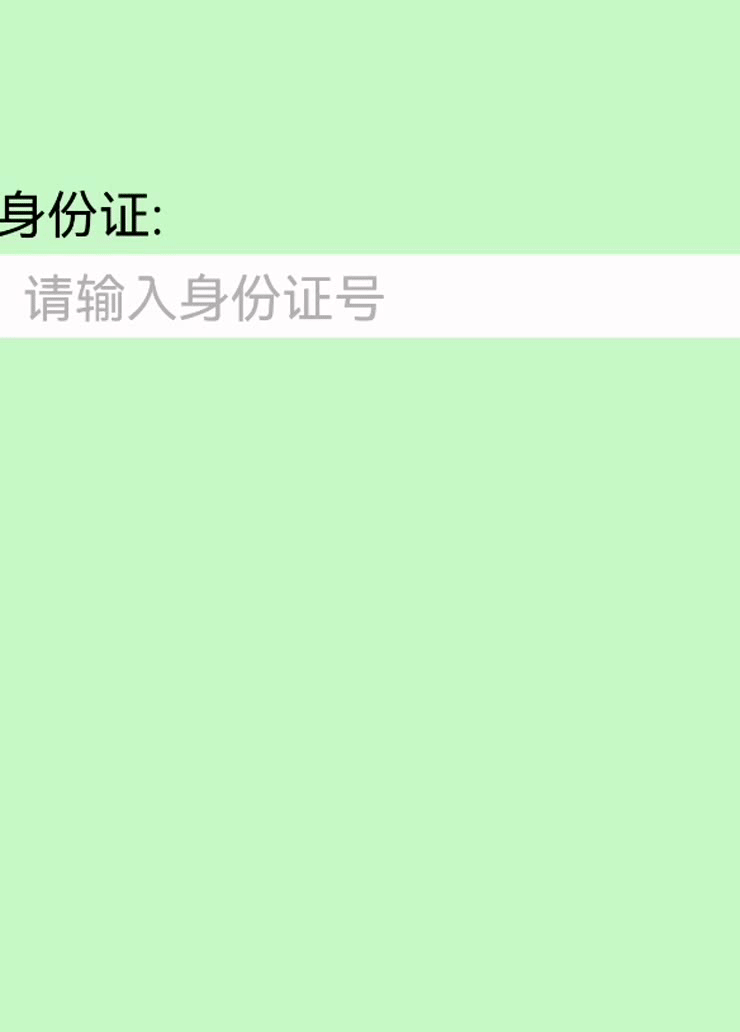
我们先来看看布局!
首先是activity_main的实现:
在这里,主界面布局非常简单,仅需要两个TextView文本框就可以啦!
注意!!!
为什么不是EditView控件来实现输入框呢?
我们知道,TextView属于文本控件,而EditView属于输入框控件,按理说咱们需要输入内容,应该选择EditView输入框控件。
但是!!!
点击EditView输入框是会自动跳出系统自带的输入法的。这样的效果,会影响我们自定义软键盘的弹出。所以我们还需要考虑如何禁用系统自动弹出的键盘。当然,这也不难实现,只需要在onCreate中加上:
tv_shownumber.setFocusable(false);
就可以禁用系统键盘啦!
在这里,使用TextView文本框来实现数据输入!
不啰嗦了!上主布局!
activity_main.xml
<?xml version="1.0" encoding="utf-8"?> <LinearLayout xmlns:android="http://schemas.android.com/apk/res/android" xmlns:app="http://schemas.android.com/apk/res-auto" android:layout_width="match_parent" android:layout_height="match_parent" android:orientation="horizontal" android:background="#C3F4C5"> <LinearLayout android:layout_width="match_parent" android:layout_height="80dp" android:layout_gravity="center" android:orientation="vertical"> <TextView android:layout_width="wrap_content" android:layout_height="40dp" android:text="身份证:" android:gravity="left|center" android:textColor="#000000" android:textSize="25sp"/> <TextView android:id="@+id/tv_shownumber" android:onClick="show" android:layout_width="match_parent" android:layout_height="40dp" android:hint=" 请输入身份证号" android:background="#FFFFFF" android:gravity="left|center" android:textColor="#000000" android:maxLength="18" android:textSize="25sp" android:textColorHint="#B6B1B1"/> </LinearLayout> </LinearLayout>
android:onClick="show" 的意思是点击文本框之后会调用show这个方法!
接下来是自定义软键盘布局!
key.xml
<?xml version="1.0" encoding="utf-8"?> <LinearLayout xmlns:android="http://schemas.android.com/apk/res/android" android:layout_width="match_parent" android:layout_height="wrap_content" android:orientation="vertical" android:layout_gravity="bottom"> <LinearLayout android:layout_width="match_parent" android:layout_height="wrap_content" android:orientation="horizontal" android:layout_margin="10dp"> <TextView android:id="@+id/tv_show" android:layout_width="0dp" android:layout_weight="3" android:layout_height="50dp" android:textColor="#000000" android:textSize="20sp" android:maxLength="18" android:gravity="center" android:maxLines="18" android:background="@drawable/keyboard_btn" /> <Button android:id="@+id/btn_yes" android:layout_width="0dp" android:layout_weight="1" android:layout_height="wrap_content" android:text="完成" android:background="@drawable/keyboard_btn" android:textStyle="bold" android:textSize="25dp" android:layout_margin="3dp"/> </LinearLayout> <LinearLayout android:layout_width="match_parent" android:layout_height="wrap_content" android:orientation="horizontal"> <Button android:id="@+id/btn_1" android:layout_width="0dp" android:layout_height="match_parent" android:layout_weight="1" android:text="1" android:background="@drawable/keyboard_btn" android:textStyle="bold" android:textSize="40dp" android:layout_margin="3dp"/> <Button android:id="@+id/btn_2" android:layout_width="0dp" android:layout_height="match_parent" android:layout_weight="1" android:text="2" android:background="@drawable/keyboard_btn" android:textStyle="bold" android:textSize="40dp" android:layout_margin="3dp"/> <Button android:id="@+id/btn_3" android:layout_width="0dp" android:layout_height="match_parent" android:layout_weight="1" android:text="3" android:background="@drawable/keyboard_btn" android:textStyle="bold" android:textSize="40dp" android:layout_margin="3dp"/> </LinearLayout> <LinearLayout android:layout_width="match_parent" android:layout_height="wrap_content" android:orientation="horizontal"> <Button android:id="@+id/btn_4" android:layout_width="0dp" android:layout_height="match_parent" android:layout_weight="1" android:text="4" android:background="@drawable/keyboard_btn" android:textStyle="bold" android:textSize="40dp" android:layout_margin="3dp"/> <Button android:id="@+id/btn_5" android:layout_width="0dp" android:layout_height="match_parent" android:layout_weight="1" android:text="5" android:background="@drawable/keyboard_btn" android:textStyle="bold" android:textSize="40dp" android:layout_margin="3dp"/> <Button android:id="@+id/btn_6" android:layout_width="0dp" android:layout_height="match_parent" android:layout_weight="1" android:text="6" android:background="@drawable/keyboard_btn" android:textStyle="bold" android:textSize="40dp" android:layout_margin="3dp"/> </LinearLayout> <LinearLayout android:layout_width="match_parent" android:layout_height="wrap_content" android:orientation="horizontal"> <Button android:id="@+id/btn_7" android:layout_width="0dp" android:layout_height="match_parent" android:layout_weight="1" android:text="7" android:background="@drawable/keyboard_btn" android:textStyle="bold" android:textSize="40dp" android:layout_margin="3dp"/> <Button android:id="@+id/btn_8" android:layout_width="0dp" android:layout_height="match_parent" android:layout_weight="1" android:text="8" android:background="@drawable/keyboard_btn" android:textStyle="bold" android:textSize="40dp" android:layout_margin="3dp"/> <Button android:id="@+id/btn_9" android:layout_width="0dp" android:layout_height="match_parent" android:layout_weight="1" android:text="9" android:background="@drawable/keyboard_btn" android:textStyle="bold" android:textSize="40dp" android:layout_margin="3dp"/> </LinearLayout> <LinearLayout android:layout_width="match_parent" android:layout_height="wrap_content" android:orientation="horizontal"> <Button android:id="@+id/btn_0" android:layout_width="0dp" android:layout_height="match_parent" android:layout_weight="1" android:text="0" android:background="@drawable/keyboard_btn" android:textStyle="bold" android:textSize="40dp" android:layout_margin="3dp"/> <Button android:id="@+id/btn_X" android:layout_width="0dp" android:layout_height="match_parent" android:layout_weight="1" android:text="X" android:background="@drawable/keyboard_btn" android:textStyle="bold" android:textSize="40dp" android:layout_margin="3dp"/> <Button android:id="@+id/btn_del" android:layout_width="0dp" android:layout_height="match_parent" android:layout_weight="1" android:text="←" android:background="@drawable/keyboard_btn" android:textStyle="bold" android:textSize="40dp" android:layout_margin="3dp"/> </LinearLayout> </LinearLayout>
代码很长,但总结起来就是13个按键加上一个TextView文本框。这样一想是不是瞬间觉得毫无难度啦!
布局代码到这里就完成了!
如果你想让你的键盘看起来好看一些,点击有颜色变化效果,也可以给它设置样式!
这是按钮没有皮肤的样子:
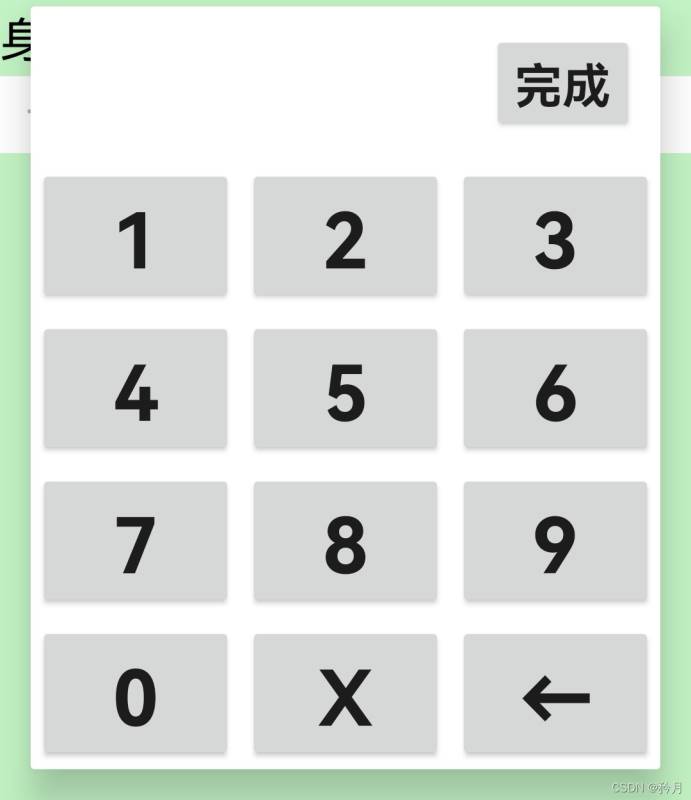
这是按钮有皮肤的样子:
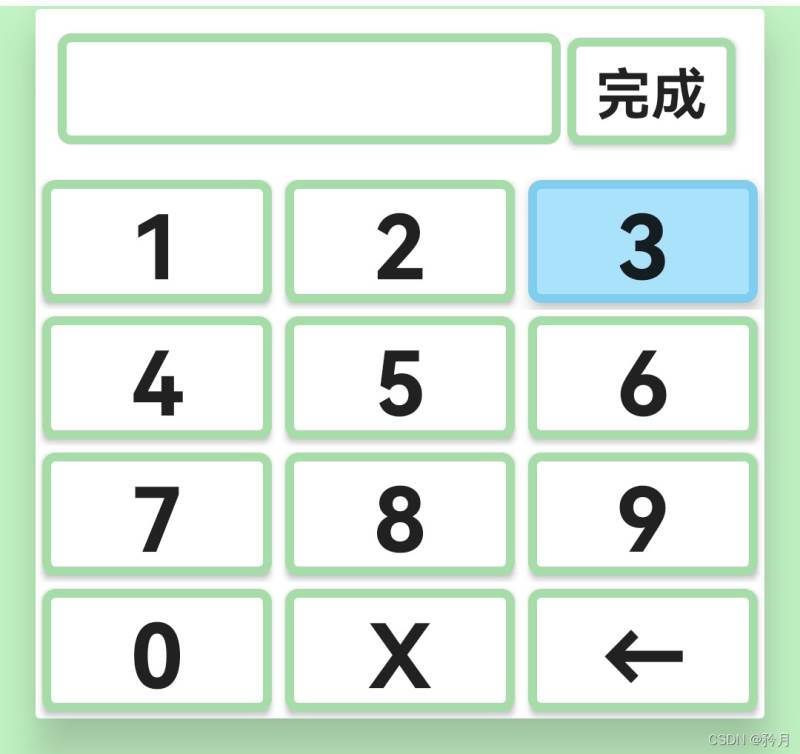
差别还是挺大的!
下面附上按钮样式的代码:
keyboard_btn.xml
<?xml version="1.0" encoding="utf-8"?> <selector xmlns:android="http://schemas.android.com/apk/res/android"> <item android:state_pressed="true"> <shape> <!--圆角大小--> <corners android:radius="4dp"/> <!--距离--> <padding android:bottom="1dp" android:left="1dp" android:right="1dp" android:top="1dp"/> <!--点击边框颜色--> <stroke android:color="#81CDEF" android:width="4dp"/> <!--点击填充颜色--> <solid android:color="#AAE2FB"/> </shape> </item> <item android:state_enabled="false"> <shape> <corners android:radius="4dp"/> <padding android:bottom="1dp" android:left="1dp" android:right="1dp" android:top="1dp"/> </shape> </item> <item> <shape> <corners android:radius="4dp"/> <padding android:bottom="1dp" android:left="1dp" android:right="1dp" android:top="1dp"/> <solid android:color="#ffffff"/> <stroke android:width="4dp" android:color="#A5DCA7"/> </shape> </item> </selector>
当然,不仅键盘按钮需要皮肤,键盘本身也需要!
这是键盘没有皮肤的样子:
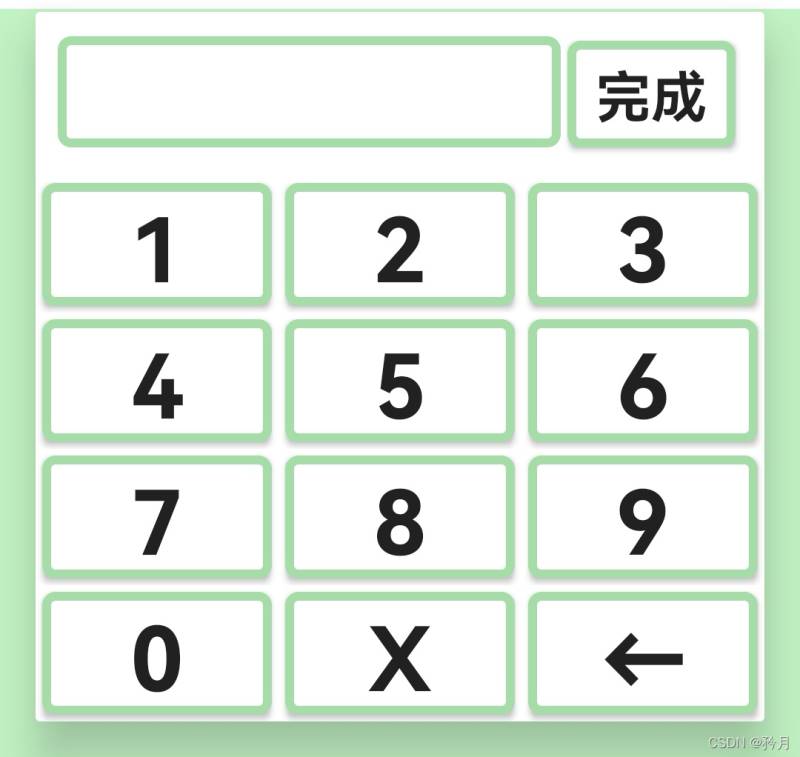
这是键盘有皮肤的样子:
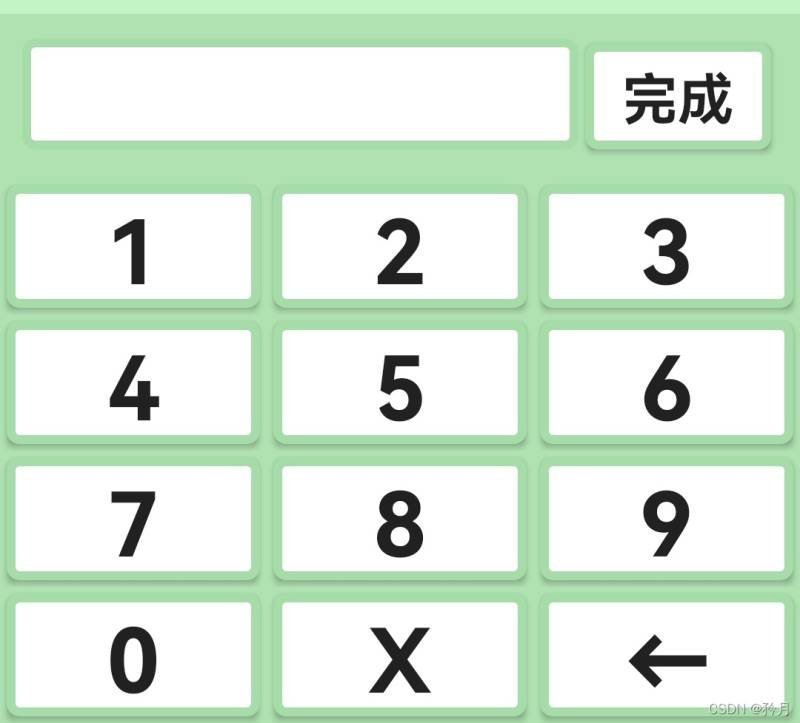
下面是键盘样式的代码:
DialogStyle.xml
<resources xmlns:tools="http://schemas.android.com/tools"> <style name="DialogStyle" android:parent="@android:style/Theme.Dialog" xmlns:android="http://schemas.android.com/apk/res/android"> <!--<!– 背景颜色 –>--> <item name="android:windowBackground">#AFE1B1</item> <item name="android:windowContentOverlay">@null</item> <!-- 浮于Activity之上 --> <item name="android:windowIsFloating">true</item> <!--<!– 边框 –>--> <item name="android:windowFrame">@null</item> </style> </resources>
在这里,浮于Activity之上的设置是非常重要的!
它使得我们整个键盘的宽度也发生了改变!
关于xml文件的存放位置,我们一般将activity_main.xml和key.xml放在layout文件夹下,将keyboard_btn.xml放在drawable文件夹下,DialogStyle.xml放在values文件夹下。
有了好看的皮囊,自然也需要有趣的灵魂!
它来了它来了!
MainActivity
package com.example.mydialog;
import androidx.appcompat.app.AlertDialog;
import androidx.appcompat.app.AppCompatActivity;
import android.app.Dialog;
import android.os.Bundle;
import android.view.Display;
import android.view.Gravity;
import android.view.LayoutInflater;
import android.view.View;
import android.view.Window;
import android.view.WindowManager;
import android.widget.Button;
import android.widget.EditText;
import android.widget.TextView;
public class MainActivity extends AppCompatActivity implements View.OnClickListener{
private TextView tv_shownumber;
// private EditText tv_shownumber;
private String shownumber;
private Dialog dialog;
@Override
protected void onCreate(Bundle savedInstanceState) {
super.onCreate(savedInstanceState);
setContentView(R.layout.activity_main);
tv_shownumber = findViewById(R.id.tv_shownumber);
}
private String num[] = {"0", "1", "2", "3", "4", "5", "6", "7", "8", "9","X"};
private String data = "";
@Override
public void onClick(View v) {
shownumber = tv_shownumber.getText().toString();
switch (v.getId()){
case R.id.btn_0:
data += num[0];
tv_shownumber.setText(data);
tv_show.setText(data);
break;
case R.id.btn_1:
data += num[1];
tv_shownumber.setText(data);
tv_show.setText(data);
break;
case R.id.btn_2:
data += num[2];
tv_shownumber.setText(data);
tv_show.setText(data);
break;
case R.id.btn_3:
data += num[3];
tv_shownumber.setText(data);
tv_show.setText(data);
break;
case R.id.btn_4:
data += num[4];
tv_shownumber.setText(data);
tv_show.setText(data);
break;
case R.id.btn_5:
data += num[5];
tv_shownumber.setText(data);
tv_show.setText(data);
break;
case R.id.btn_6:
data += num[6];
tv_shownumber.setText(data);
tv_show.setText(data);
break;
case R.id.btn_7:
data += num[7];
tv_shownumber.setText(data);
tv_show.setText(data);
break;
case R.id.btn_8:
data += num[8];
tv_shownumber.setText(data);
tv_show.setText(data);
break;
case R.id.btn_9:
data += num[9];
tv_shownumber.setText(data);
tv_show.setText(data);
break;
case R.id.btn_X:
data += num[10];
tv_shownumber.setText(data);
tv_show.setText(data);
break;
case R.id.btn_yes:
dialog.dismiss();
break;
case R.id.btn_del:
data = data.substring(0, data.length() - 1);
tv_shownumber.setText(data);
tv_show.setText(data);
break;
default:
break;
}
}
private View inflate;
private Button btn_0;
private Button btn_1;
private Button btn_2;
private Button btn_3;
private Button btn_4;
private Button btn_5;
private Button btn_6;
private Button btn_7;
private Button btn_8;
private Button btn_9;
private Button btn_X;
private Button btn_yes;
private Button btn_del;
private TextView tv_show;
public void show(View view){
dialog =new Dialog(this,R.style.DialogStyle);
inflate = LayoutInflater.from(this).inflate(R.layout.key, null);//动态添加布局
btn_0 = inflate.findViewById(R.id.btn_0);
btn_1 = inflate.findViewById(R.id.btn_1);
btn_2 = inflate.findViewById(R.id.btn_2);
btn_3 = inflate.findViewById(R.id.btn_3);
btn_4 = inflate.findViewById(R.id.btn_4);
btn_5 = inflate.findViewById(R.id.btn_5);
btn_6 = inflate.findViewById(R.id.btn_6);
btn_7 = inflate.findViewById(R.id.btn_7);
btn_8 = inflate.findViewById(R.id.btn_8);
btn_9 = inflate.findViewById(R.id.btn_9);
btn_X = inflate.findViewById(R.id.btn_X);
btn_yes = inflate.findViewById(R.id.btn_yes);
btn_del = inflate.findViewById(R.id.btn_del);
tv_show = inflate.findViewById(R.id.tv_show);
btn_1.setOnClickListener(this);
btn_2.setOnClickListener(this);
btn_3.setOnClickListener(this);
btn_4.setOnClickListener(this);
btn_5.setOnClickListener(this);
btn_6.setOnClickListener(this);
btn_7.setOnClickListener(this);
btn_8.setOnClickListener(this);
btn_9.setOnClickListener(this);
btn_X.setOnClickListener(this);
btn_0.setOnClickListener(this);
btn_yes.setOnClickListener(this);
btn_del.setOnClickListener(this);
dialog.setContentView(inflate);
Window dialogWindow = dialog.getWindow();
WindowManager m = getWindowManager();
Display d = m.getDefaultDisplay(); // 获取屏幕宽、高用
WindowManager.LayoutParams p = dialogWindow.getAttributes(); // 获取对话框当前的参数值
p.dimAmount = 0f;//设置背景透明度
dialogWindow.setGravity(Gravity.BOTTOM);
p.width =d.getWidth();//设置键盘的宽度
dialogWindow.setAttributes(p);
dialog.show();
}
}主代码中为每个按键设置了功能,并引入了动态布局key.xml,实现了show()方法,让自定义键盘以对话框的形式弹出!
在这里,背景透明度的设置可以使键盘的出现更加平滑,这一项的设置也可以在xml中进行哦!
dialogWindow.setGravity( Gravity.BOTTOM);
这句话的作用是让我们键盘的位置位于页面底部。
到此,相信大家对“Android以对话框形式制作数字软键盘怎么实现”有了更深的了解,不妨来实际操作一番吧!这里是亿速云网站,更多相关内容可以进入相关频道进行查询,关注我们,继续学习!
免责声明:本站发布的内容(图片、视频和文字)以原创、转载和分享为主,文章观点不代表本网站立场,如果涉及侵权请联系站长邮箱:is@yisu.com进行举报,并提供相关证据,一经查实,将立刻删除涉嫌侵权内容。